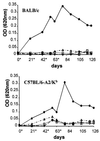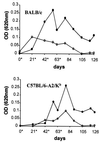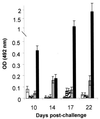DNA immunization with Trypanosoma cruzi HSP70 fused to the KMP11 protein elicits a cytotoxic and humoral immune response against the antigen and leads to protection
- PMID: 11553607
- PMCID: PMC98798
- DOI: 10.1128/IAI.69.10.6558-6563.2001
DNA immunization with Trypanosoma cruzi HSP70 fused to the KMP11 protein elicits a cytotoxic and humoral immune response against the antigen and leads to protection
Abstract
Murine immunization with Trypanosoma cruzi KMP11-HSP70 fused genes but not the KMP11 gene alone elicited both an immunoglobulin G2a long-lasting humoral immune response against KMP11 protein and activation of CD8+ cytotoxic T lymphocytes specific for two KMP11 peptides containing A2 motifs. Moreover, protection against the parasite challenge was observed after immunization with the chimeric gene.
Figures






 represent the means of optical density (OD) values ± SD of the sera of three mice immunized with pCMV4.11.70 that survived or died, respectively, after the T. cruzi challenge.
represent the means of optical density (OD) values ± SD of the sera of three mice immunized with pCMV4.11.70 that survived or died, respectively, after the T. cruzi challenge.Similar articles
-
The genetic immunization with paraflagellar rod protein-2 fused to the HSP70 confers protection against late Trypanosoma cruzi infection.Vaccine. 2006 Nov 30;24(49-50):7046-55. doi: 10.1016/j.vaccine.2006.07.006. Epub 2006 Jul 21. Vaccine. 2006. PMID: 16901590
-
Genetic immunization elicits antigen-specific protective immune responses and decreases disease severity in Trypanosoma cruzi infection.Infect Immun. 2002 Oct;70(10):5547-55. doi: 10.1128/IAI.70.10.5547-5555.2002. Infect Immun. 2002. PMID: 12228281 Free PMC article.
-
Identification of HLA-A∗02:01-restricted CTL epitopes in Trypanosoma cruzi heat shock protein-70 recognized by Chagas disease patients.Microbes Infect. 2011 Nov;13(12-13):1025-32. doi: 10.1016/j.micinf.2011.05.010. Epub 2011 Jun 12. Microbes Infect. 2011. PMID: 21704723
-
Advances and challenges towards a vaccine against Chagas disease.Hum Vaccin. 2011 Nov;7(11):1184-91. doi: 10.4161/hv.7.11.17016. Epub 2011 Nov 1. Hum Vaccin. 2011. PMID: 22048121 Free PMC article. Review.
-
Protective immunity against lethal anaphylactic reaction in Toxoplasma gondii-infected mice by DNA vaccination with T. gondii-derived heat shock protein 70 gene.Parasitol Int. 2010 Jun;59(2):105-11. doi: 10.1016/j.parint.2010.03.006. Epub 2010 Mar 24. Parasitol Int. 2010. PMID: 20346412 Review.
Cited by
-
Impact of benznidazole treatment on the functional response of Trypanosoma cruzi antigen-specific CD4+CD8+ T cells in chronic Chagas disease patients.PLoS Negl Trop Dis. 2018 May 11;12(5):e0006480. doi: 10.1371/journal.pntd.0006480. eCollection 2018 May. PLoS Negl Trop Dis. 2018. PMID: 29750791 Free PMC article.
-
Immunization with cDNA expressed by amastigotes of Trypanosoma cruzi elicits protective immune response against experimental infection.Infect Immun. 2003 May;71(5):2744-57. doi: 10.1128/IAI.71.5.2744-2757.2003. Infect Immun. 2003. PMID: 12704149 Free PMC article.
-
Mucosal adjuvanticity of a Shigella invasin complex with dna-based vaccines.Clin Vaccine Immunol. 2009 Apr;16(4):574-86. doi: 10.1128/CVI.00435-08. Epub 2009 Feb 18. Clin Vaccine Immunol. 2009. PMID: 19225079 Free PMC article.
-
Prophylactic efficacy of TcVac2 against Trypanosoma cruzi in mice.PLoS Negl Trop Dis. 2010 Aug 10;4(8):e797. doi: 10.1371/journal.pntd.0000797. PLoS Negl Trop Dis. 2010. PMID: 20706586 Free PMC article.
-
An Animal Model of Acute and Chronic Chagas Disease With the Reticulotropic Y Strain of Trypanosoma cruzi That Depicts the Multifunctionality and Dysfunctionality of T Cells.Front Immunol. 2019 Apr 26;10:918. doi: 10.3389/fimmu.2019.00918. eCollection 2019. Front Immunol. 2019. PMID: 31105709 Free PMC article.
References
-
- Binder R J, Han D K, Srivastava P K. CD91: a receptor for heat shock protein gp96. Nat Immunol. 2000;1:151–155. - PubMed
-
- Brodskyn C I, Silva A M, Takehara H A, Mota I. IgG subclasses responsible for immune clearance in mice infected with Trypanosoma cruzi. Immunol Cell Biol. 1989;67:343–348. - PubMed
-
- Burleigh B A, Andrews N W. The mechanisms of Trypanosoma cruzi invasion of mammalian cells. Annu Rev Microbiol. 1995;49:175–200. - PubMed
-
- Chow Y H, Chiang B L, Lee Y L, Chi W K, Lin W C, Chen Y T, Tao M H. Development of Th1 and Th2 populations and the nature of immune responses to hepatitis B virus DNA vaccines can be modulated by codelivery of various cytokine genes. J Immunol. 1998;160:1320–1329. - PubMed
Publication types
MeSH terms
Substances
LinkOut - more resources
Full Text Sources
Other Literature Sources
Medical
Research Materials

